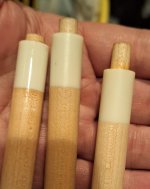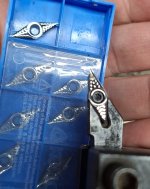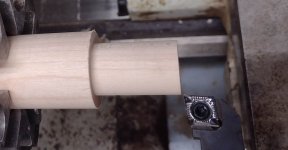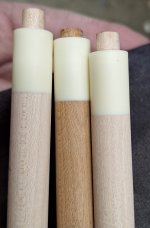The Sumitomo rep was in at work about 3 weeks ago, gave me a new insert to try. The radius is 0.05mm on a VCMT11 insert, 35 deg included angle. It is a ground insert on the outer shape. There are also other very sharp inserts for turning plastics and copper etc, Iscar make a series that is used by the places that make oil seals and special seals etc. They come in all sorts of radius and insert geometries. Often these sharp inserts are a cermet grade, or a micrograin carbide. There is also nano coating systems on the inserts, especially the dlc or diamond like coatings.
They are great for abrasive materials. Just dont run them fast and will last a very long time. By sharp, I am referring to the cutting edge sharp, not a small radius sharp.
The sharp inserts are available in a wide range of insert types, but the more common insert tyes are the TNGG16, Triangle insert and can be used on both side, so 6 edges, the DCMT11, 55 deg insert, only 2 edges, the VNGG16 insert, 35 deg insert, double sided, 4 edges, smaller VCGT11 35deg insert, 2 edges, and the CCGT09 Rhomboid insert, 2 cutting edges.
I like the Kyocera CCGT09T302MP-CK -PR1125, and the TNGG160402R-S PR1125 These two by Kyocera are my favourites, as they allow the ability to cut materials from wood to plastics, right up to cutting bearing races on their end faces to thin them up.
I keep the inserts in their material groups, in its own box. So wood, plastics, Ali, Steel etc. That way the inserts have a much longer life.
On the lighter lathes like cue lathes, I find these sharp ground inserts to be very good.
They are great for abrasive materials. Just dont run them fast and will last a very long time. By sharp, I am referring to the cutting edge sharp, not a small radius sharp.
The sharp inserts are available in a wide range of insert types, but the more common insert tyes are the TNGG16, Triangle insert and can be used on both side, so 6 edges, the DCMT11, 55 deg insert, only 2 edges, the VNGG16 insert, 35 deg insert, double sided, 4 edges, smaller VCGT11 35deg insert, 2 edges, and the CCGT09 Rhomboid insert, 2 cutting edges.
I like the Kyocera CCGT09T302MP-CK -PR1125, and the TNGG160402R-S PR1125 These two by Kyocera are my favourites, as they allow the ability to cut materials from wood to plastics, right up to cutting bearing races on their end faces to thin them up.
I keep the inserts in their material groups, in its own box. So wood, plastics, Ali, Steel etc. That way the inserts have a much longer life.
On the lighter lathes like cue lathes, I find these sharp ground inserts to be very good.






